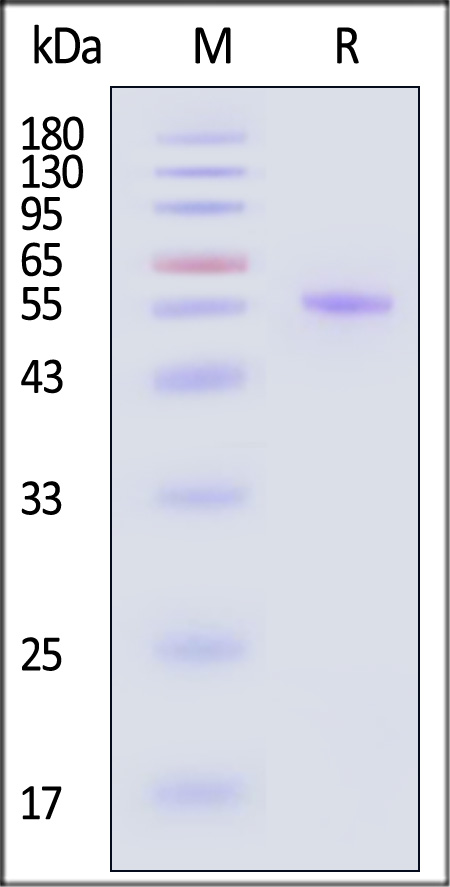分子别名(Synonym)
BTNL2
表达区间及表达系统(Source)
Biotinylated Human BTNL2 Protein, His,Avitag (BT2-H81Q5) is expressed from E. coli cells. It contains AA Lys 24 - Trp 455 (Accession # NP_062548.1).
Predicted N-terminus: Met
Request for sequence
蛋白结构(Molecular Characterization)

This protein carries a polyhistidine tag at the N-terminus, followed by an Avi tag (Avitag™)
The protein has a calculated MW of 51.6 kDa. The protein migrates as 55-57 kDa when calibrated against Star Ribbon Pre-stained Protein Marker under reducing (R) condition (SDS-PAGE).
标记(Labeling)
Biotinylation of this product is performed using Avitag™ technology. Briefly, the single lysine residue in the Avitag is enzymatically labeled with biotin.
蛋白标记度(Protein Ratio)
Passed as determined by the HABA assay / binding ELISA.
内毒素(Endotoxin)
Less than 1.0 EU per μg by the LAL method.
纯度(Purity)
>95% as determined by SDS-PAGE.
制剂(Formulation)
Lyophilized from 0.22 μm filtered solution in PBS, pH7.4 with trehalose as protectant.
Contact us for customized product form or formulation.
重构方法(Reconstitution)
Please see Certificate of Analysis for specific instructions.
For best performance, we strongly recommend you to follow the reconstitution protocol provided in the CoA.
存储(Storage)
For long term storage, the product should be stored at lyophilized state at -20°C or lower.
Please avoid repeated freeze-thaw cycles.
This product is stable after storage at:
- -20°C to -70°C for 12 months in lyophilized state;
- -70°C for 3 months under sterile conditions after reconstitution.
电泳(SDS-PAGE)

Biotinylated Human BTNL2 Protein, His,Avitag on SDS-PAGE under reducing (R) condition. The gel was stained with Coomassie Blue. The purity of the protein is greater than 95% (With Star Ribbon Pre-stained Protein Marker).
背景(Background)
Recently, several members of the BTN /BTNL superfamily have been implicated in T cell response. Butyrophilin-like 2 (BTNL2) is a butyrophilin family member with homology to the B7 costimulatory molecules, polymorphisms of which have been recently associated through genetic analyses to sporadic inclusion body myositis and sarcoidosis.























































 膜杰作
膜杰作 Star Staining
Star Staining












